Human Resource Development Report: Hilton Hotel's HR Strategies
VerifiedAdded on 2020/10/04
|21
|5165
|114
Report
AI Summary
This report provides a detailed analysis of human resource development (HRD) practices within the Hilton Hotel. It begins by exploring various learning styles, including Kolb's and Honey & Mumford's models, and their application in enhancing employee knowledge and skills. The report then delves into the concept of the learning curve and its significance in the workplace, highlighting the importance of learning transfer. Furthermore, it examines the necessity of training and development at different organizational levels, comparing the training requirements for staff at various levels and outlining the benefits and drawbacks of training programs. A systematic approach to planning training events is also presented. The report also covers the role of government in training, development, and lifelong learning, the impact of the competency movement, and contemporary training initiatives. Finally, the report evaluates the usefulness of training programs through feedback and evaluation forms.
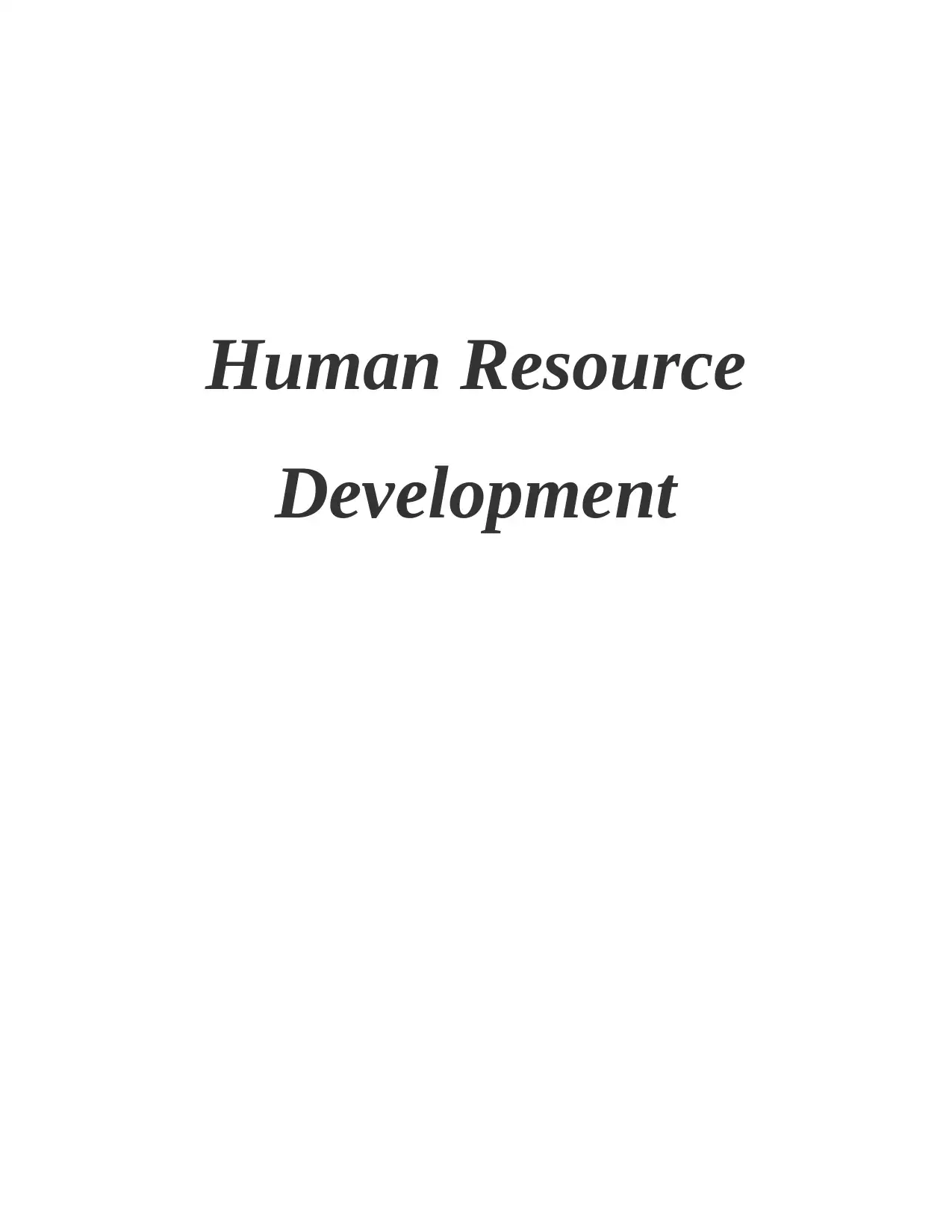
Human Resource
Development
Development
Paraphrase This Document
Need a fresh take? Get an instant paraphrase of this document with our AI Paraphraser
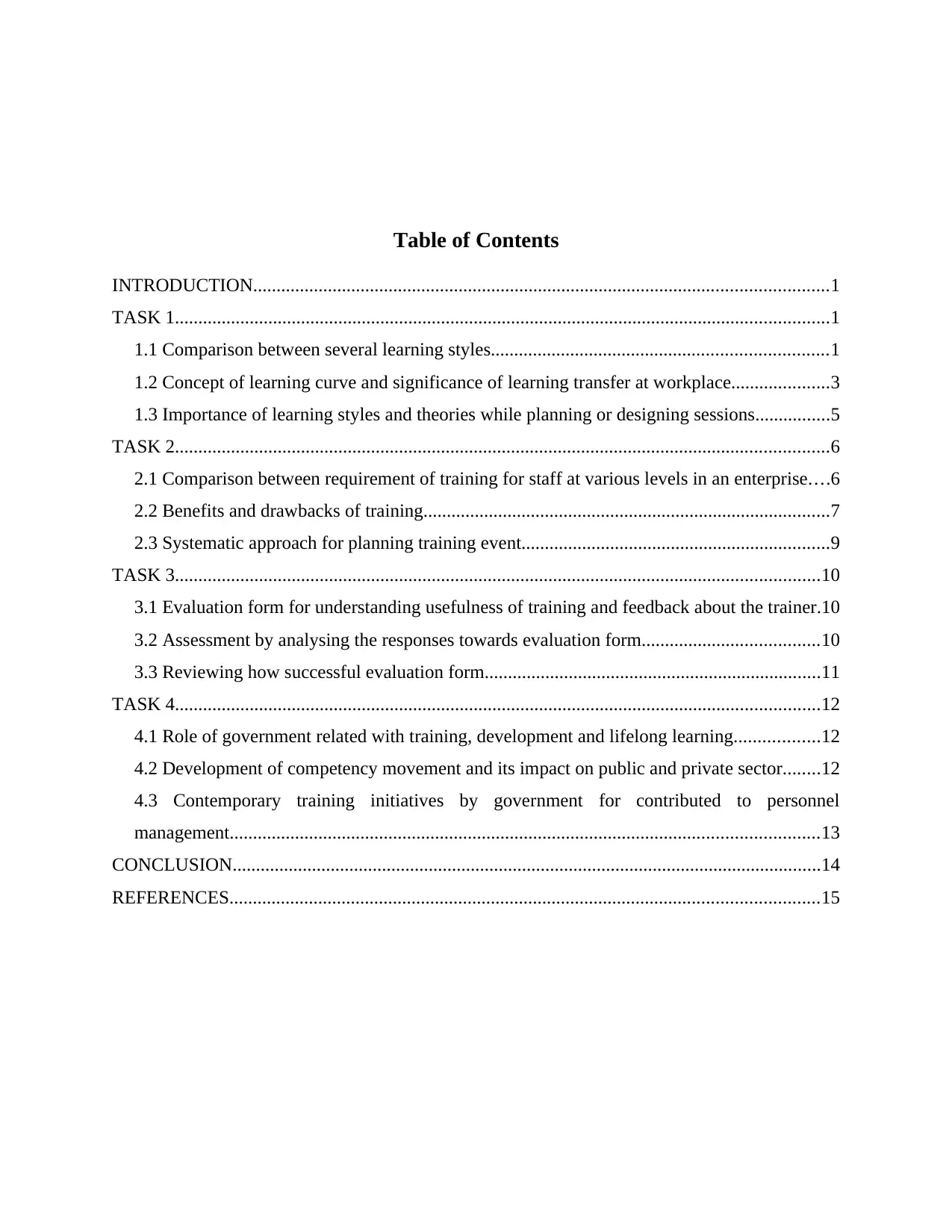
Table of Contents
INTRODUCTION...........................................................................................................................1
TASK 1............................................................................................................................................1
1.1 Comparison between several learning styles........................................................................1
1.2 Concept of learning curve and significance of learning transfer at workplace.....................3
1.3 Importance of learning styles and theories while planning or designing sessions................5
TASK 2............................................................................................................................................6
2.1 Comparison between requirement of training for staff at various levels in an enterprise....6
2.2 Benefits and drawbacks of training.......................................................................................7
2.3 Systematic approach for planning training event..................................................................9
TASK 3..........................................................................................................................................10
3.1 Evaluation form for understanding usefulness of training and feedback about the trainer.10
3.2 Assessment by analysing the responses towards evaluation form......................................10
3.3 Reviewing how successful evaluation form........................................................................11
TASK 4..........................................................................................................................................12
4.1 Role of government related with training, development and lifelong learning..................12
4.2 Development of competency movement and its impact on public and private sector........12
4.3 Contemporary training initiatives by government for contributed to personnel
management..............................................................................................................................13
CONCLUSION..............................................................................................................................14
REFERENCES..............................................................................................................................15
INTRODUCTION...........................................................................................................................1
TASK 1............................................................................................................................................1
1.1 Comparison between several learning styles........................................................................1
1.2 Concept of learning curve and significance of learning transfer at workplace.....................3
1.3 Importance of learning styles and theories while planning or designing sessions................5
TASK 2............................................................................................................................................6
2.1 Comparison between requirement of training for staff at various levels in an enterprise....6
2.2 Benefits and drawbacks of training.......................................................................................7
2.3 Systematic approach for planning training event..................................................................9
TASK 3..........................................................................................................................................10
3.1 Evaluation form for understanding usefulness of training and feedback about the trainer.10
3.2 Assessment by analysing the responses towards evaluation form......................................10
3.3 Reviewing how successful evaluation form........................................................................11
TASK 4..........................................................................................................................................12
4.1 Role of government related with training, development and lifelong learning..................12
4.2 Development of competency movement and its impact on public and private sector........12
4.3 Contemporary training initiatives by government for contributed to personnel
management..............................................................................................................................13
CONCLUSION..............................................................................................................................14
REFERENCES..............................................................................................................................15
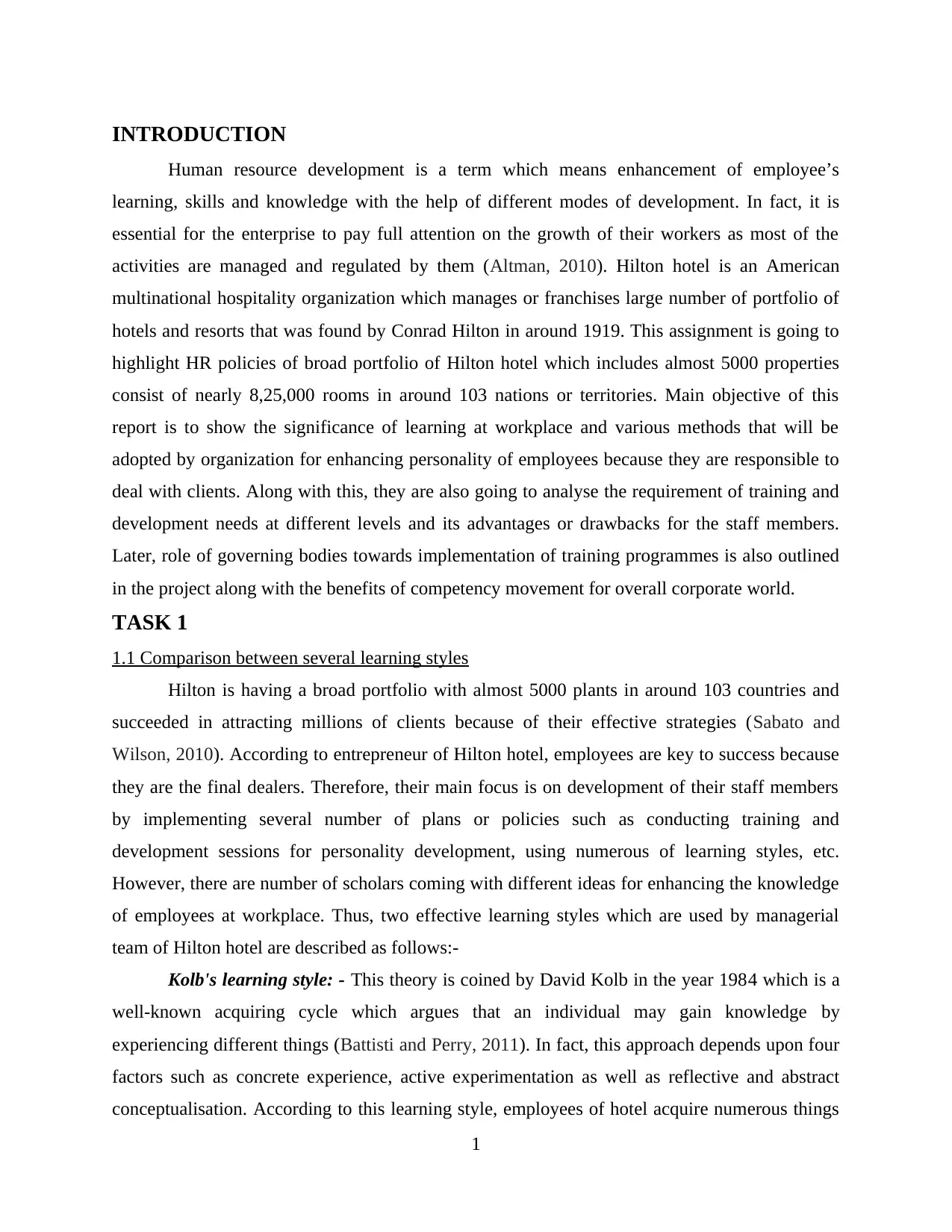
INTRODUCTION
Human resource development is a term which means enhancement of employee’s
learning, skills and knowledge with the help of different modes of development. In fact, it is
essential for the enterprise to pay full attention on the growth of their workers as most of the
activities are managed and regulated by them (Altman, 2010). Hilton hotel is an American
multinational hospitality organization which manages or franchises large number of portfolio of
hotels and resorts that was found by Conrad Hilton in around 1919. This assignment is going to
highlight HR policies of broad portfolio of Hilton hotel which includes almost 5000 properties
consist of nearly 8,25,000 rooms in around 103 nations or territories. Main objective of this
report is to show the significance of learning at workplace and various methods that will be
adopted by organization for enhancing personality of employees because they are responsible to
deal with clients. Along with this, they are also going to analyse the requirement of training and
development needs at different levels and its advantages or drawbacks for the staff members.
Later, role of governing bodies towards implementation of training programmes is also outlined
in the project along with the benefits of competency movement for overall corporate world.
TASK 1
1.1 Comparison between several learning styles
Hilton is having a broad portfolio with almost 5000 plants in around 103 countries and
succeeded in attracting millions of clients because of their effective strategies (Sabato and
Wilson, 2010). According to entrepreneur of Hilton hotel, employees are key to success because
they are the final dealers. Therefore, their main focus is on development of their staff members
by implementing several number of plans or policies such as conducting training and
development sessions for personality development, using numerous of learning styles, etc.
However, there are number of scholars coming with different ideas for enhancing the knowledge
of employees at workplace. Thus, two effective learning styles which are used by managerial
team of Hilton hotel are described as follows:-
Kolb's learning style: - This theory is coined by David Kolb in the year 1984 which is a
well-known acquiring cycle which argues that an individual may gain knowledge by
experiencing different things (Battisti and Perry, 2011). In fact, this approach depends upon four
factors such as concrete experience, active experimentation as well as reflective and abstract
conceptualisation. According to this learning style, employees of hotel acquire numerous things
1
Human resource development is a term which means enhancement of employee’s
learning, skills and knowledge with the help of different modes of development. In fact, it is
essential for the enterprise to pay full attention on the growth of their workers as most of the
activities are managed and regulated by them (Altman, 2010). Hilton hotel is an American
multinational hospitality organization which manages or franchises large number of portfolio of
hotels and resorts that was found by Conrad Hilton in around 1919. This assignment is going to
highlight HR policies of broad portfolio of Hilton hotel which includes almost 5000 properties
consist of nearly 8,25,000 rooms in around 103 nations or territories. Main objective of this
report is to show the significance of learning at workplace and various methods that will be
adopted by organization for enhancing personality of employees because they are responsible to
deal with clients. Along with this, they are also going to analyse the requirement of training and
development needs at different levels and its advantages or drawbacks for the staff members.
Later, role of governing bodies towards implementation of training programmes is also outlined
in the project along with the benefits of competency movement for overall corporate world.
TASK 1
1.1 Comparison between several learning styles
Hilton is having a broad portfolio with almost 5000 plants in around 103 countries and
succeeded in attracting millions of clients because of their effective strategies (Sabato and
Wilson, 2010). According to entrepreneur of Hilton hotel, employees are key to success because
they are the final dealers. Therefore, their main focus is on development of their staff members
by implementing several number of plans or policies such as conducting training and
development sessions for personality development, using numerous of learning styles, etc.
However, there are number of scholars coming with different ideas for enhancing the knowledge
of employees at workplace. Thus, two effective learning styles which are used by managerial
team of Hilton hotel are described as follows:-
Kolb's learning style: - This theory is coined by David Kolb in the year 1984 which is a
well-known acquiring cycle which argues that an individual may gain knowledge by
experiencing different things (Battisti and Perry, 2011). In fact, this approach depends upon four
factors such as concrete experience, active experimentation as well as reflective and abstract
conceptualisation. According to this learning style, employees of hotel acquire numerous things
1
⊘ This is a preview!⊘
Do you want full access?
Subscribe today to unlock all pages.

Trusted by 1+ million students worldwide
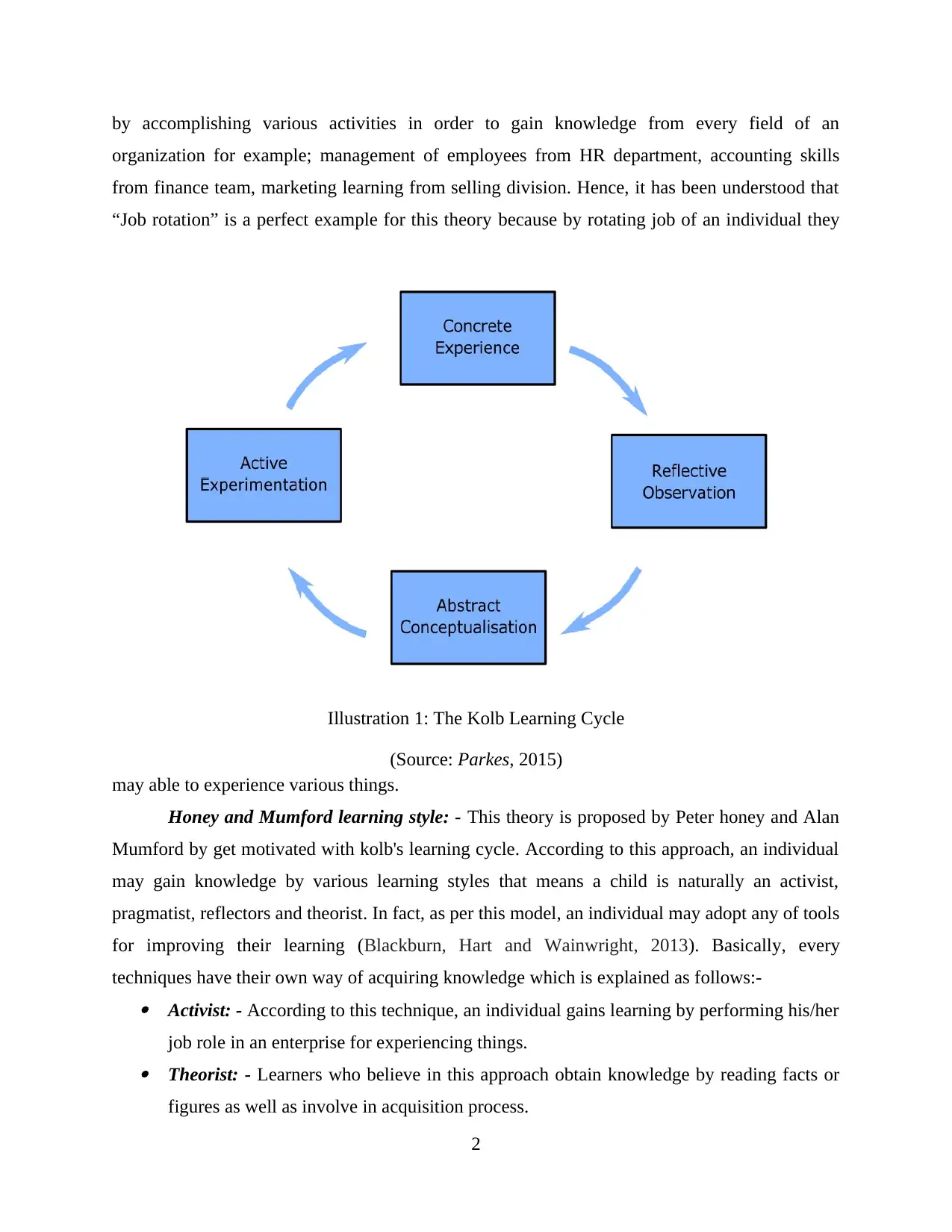
by accomplishing various activities in order to gain knowledge from every field of an
organization for example; management of employees from HR department, accounting skills
from finance team, marketing learning from selling division. Hence, it has been understood that
“Job rotation” is a perfect example for this theory because by rotating job of an individual they
may able to experience various things.
Honey and Mumford learning style: - This theory is proposed by Peter honey and Alan
Mumford by get motivated with kolb's learning cycle. According to this approach, an individual
may gain knowledge by various learning styles that means a child is naturally an activist,
pragmatist, reflectors and theorist. In fact, as per this model, an individual may adopt any of tools
for improving their learning (Blackburn, Hart and Wainwright, 2013). Basically, every
techniques have their own way of acquiring knowledge which is explained as follows:- Activist: - According to this technique, an individual gains learning by performing his/her
job role in an enterprise for experiencing things. Theorist: - Learners who believe in this approach obtain knowledge by reading facts or
figures as well as involve in acquisition process.
2
Illustration 1: The Kolb Learning Cycle
(Source: Parkes, 2015)
organization for example; management of employees from HR department, accounting skills
from finance team, marketing learning from selling division. Hence, it has been understood that
“Job rotation” is a perfect example for this theory because by rotating job of an individual they
may able to experience various things.
Honey and Mumford learning style: - This theory is proposed by Peter honey and Alan
Mumford by get motivated with kolb's learning cycle. According to this approach, an individual
may gain knowledge by various learning styles that means a child is naturally an activist,
pragmatist, reflectors and theorist. In fact, as per this model, an individual may adopt any of tools
for improving their learning (Blackburn, Hart and Wainwright, 2013). Basically, every
techniques have their own way of acquiring knowledge which is explained as follows:- Activist: - According to this technique, an individual gains learning by performing his/her
job role in an enterprise for experiencing things. Theorist: - Learners who believe in this approach obtain knowledge by reading facts or
figures as well as involve in acquisition process.
2
Illustration 1: The Kolb Learning Cycle
(Source: Parkes, 2015)
Paraphrase This Document
Need a fresh take? Get an instant paraphrase of this document with our AI Paraphraser
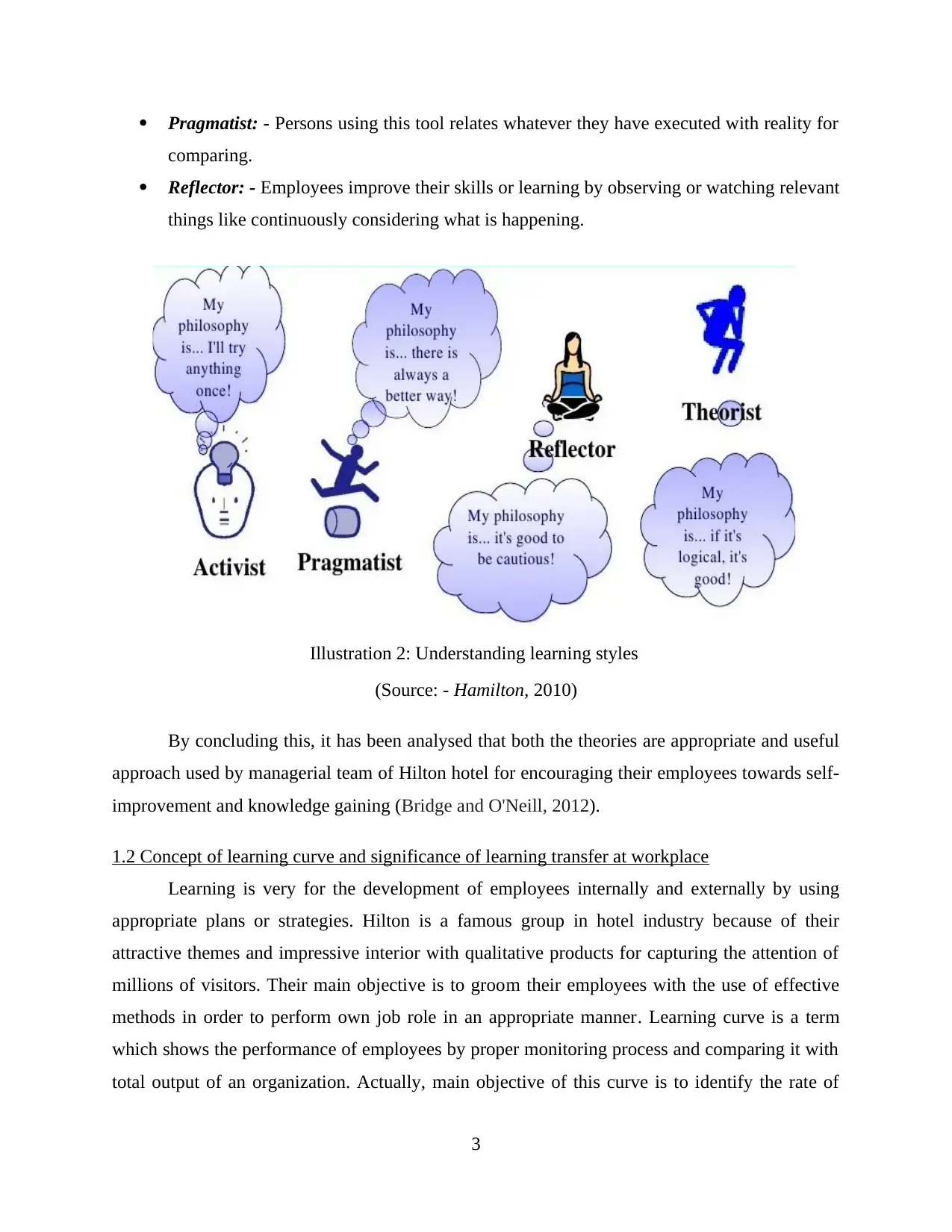
Pragmatist: - Persons using this tool relates whatever they have executed with reality for
comparing.
Reflector: - Employees improve their skills or learning by observing or watching relevant
things like continuously considering what is happening.
(Source: - Hamilton, 2010)
By concluding this, it has been analysed that both the theories are appropriate and useful
approach used by managerial team of Hilton hotel for encouraging their employees towards self-
improvement and knowledge gaining (Bridge and O'Neill, 2012).
1.2 Concept of learning curve and significance of learning transfer at workplace
Learning is very for the development of employees internally and externally by using
appropriate plans or strategies. Hilton is a famous group in hotel industry because of their
attractive themes and impressive interior with qualitative products for capturing the attention of
millions of visitors. Their main objective is to groom their employees with the use of effective
methods in order to perform own job role in an appropriate manner. Learning curve is a term
which shows the performance of employees by proper monitoring process and comparing it with
total output of an organization. Actually, main objective of this curve is to identify the rate of
3
Illustration 2: Understanding learning styles
comparing.
Reflector: - Employees improve their skills or learning by observing or watching relevant
things like continuously considering what is happening.
(Source: - Hamilton, 2010)
By concluding this, it has been analysed that both the theories are appropriate and useful
approach used by managerial team of Hilton hotel for encouraging their employees towards self-
improvement and knowledge gaining (Bridge and O'Neill, 2012).
1.2 Concept of learning curve and significance of learning transfer at workplace
Learning is very for the development of employees internally and externally by using
appropriate plans or strategies. Hilton is a famous group in hotel industry because of their
attractive themes and impressive interior with qualitative products for capturing the attention of
millions of visitors. Their main objective is to groom their employees with the use of effective
methods in order to perform own job role in an appropriate manner. Learning curve is a term
which shows the performance of employees by proper monitoring process and comparing it with
total output of an organization. Actually, main objective of this curve is to identify the rate of
3
Illustration 2: Understanding learning styles
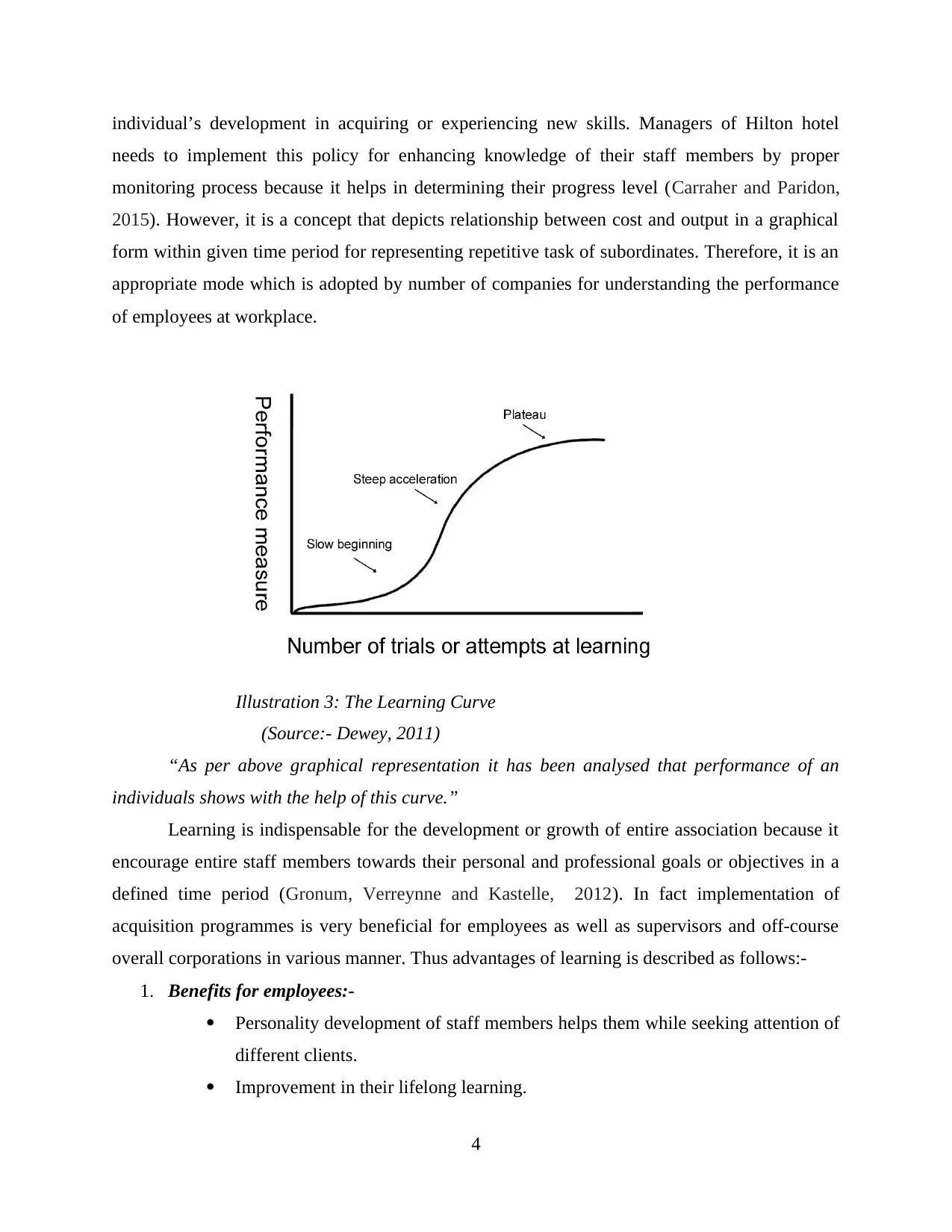
individual’s development in acquiring or experiencing new skills. Managers of Hilton hotel
needs to implement this policy for enhancing knowledge of their staff members by proper
monitoring process because it helps in determining their progress level (Carraher and Paridon,
2015). However, it is a concept that depicts relationship between cost and output in a graphical
form within given time period for representing repetitive task of subordinates. Therefore, it is an
appropriate mode which is adopted by number of companies for understanding the performance
of employees at workplace.
(Source:- Dewey, 2011)
“As per above graphical representation it has been analysed that performance of an
individuals shows with the help of this curve.”
Learning is indispensable for the development or growth of entire association because it
encourage entire staff members towards their personal and professional goals or objectives in a
defined time period (Gronum, Verreynne and Kastelle, 2012). In fact implementation of
acquisition programmes is very beneficial for employees as well as supervisors and off-course
overall corporations in various manner. Thus advantages of learning is described as follows:-
1. Benefits for employees:-
Personality development of staff members helps them while seeking attention of
different clients.
Improvement in their lifelong learning.
4
Illustration 3: The Learning Curve
needs to implement this policy for enhancing knowledge of their staff members by proper
monitoring process because it helps in determining their progress level (Carraher and Paridon,
2015). However, it is a concept that depicts relationship between cost and output in a graphical
form within given time period for representing repetitive task of subordinates. Therefore, it is an
appropriate mode which is adopted by number of companies for understanding the performance
of employees at workplace.
(Source:- Dewey, 2011)
“As per above graphical representation it has been analysed that performance of an
individuals shows with the help of this curve.”
Learning is indispensable for the development or growth of entire association because it
encourage entire staff members towards their personal and professional goals or objectives in a
defined time period (Gronum, Verreynne and Kastelle, 2012). In fact implementation of
acquisition programmes is very beneficial for employees as well as supervisors and off-course
overall corporations in various manner. Thus advantages of learning is described as follows:-
1. Benefits for employees:-
Personality development of staff members helps them while seeking attention of
different clients.
Improvement in their lifelong learning.
4
Illustration 3: The Learning Curve
⊘ This is a preview!⊘
Do you want full access?
Subscribe today to unlock all pages.

Trusted by 1+ million students worldwide
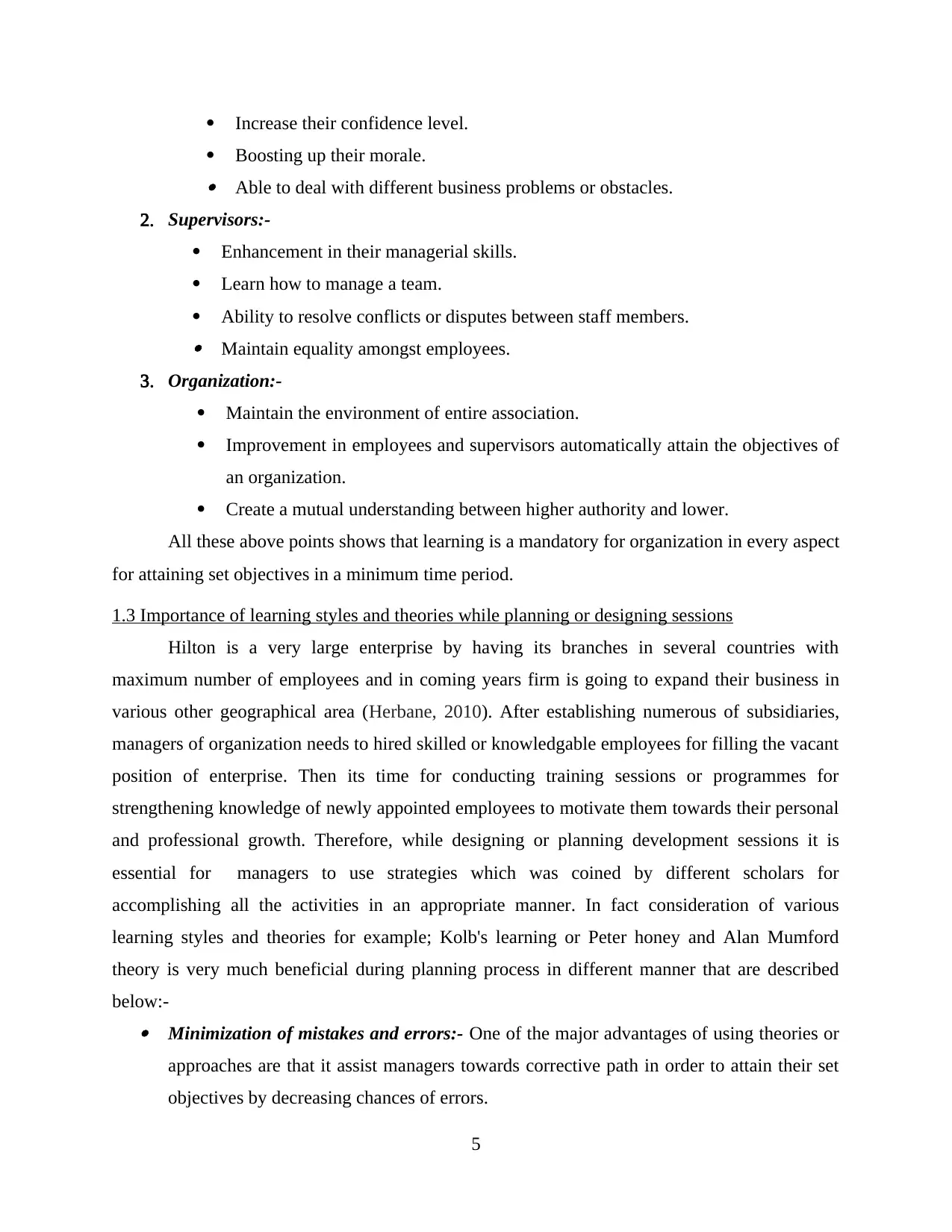
Increase their confidence level.
Boosting up their morale.
Able to deal with different business problems or obstacles.
2. Supervisors:-
Enhancement in their managerial skills.
Learn how to manage a team.
Ability to resolve conflicts or disputes between staff members.
Maintain equality amongst employees.
3. Organization:-
Maintain the environment of entire association.
Improvement in employees and supervisors automatically attain the objectives of
an organization.
Create a mutual understanding between higher authority and lower.
All these above points shows that learning is a mandatory for organization in every aspect
for attaining set objectives in a minimum time period.
1.3 Importance of learning styles and theories while planning or designing sessions
Hilton is a very large enterprise by having its branches in several countries with
maximum number of employees and in coming years firm is going to expand their business in
various other geographical area (Herbane, 2010). After establishing numerous of subsidiaries,
managers of organization needs to hired skilled or knowledgable employees for filling the vacant
position of enterprise. Then its time for conducting training sessions or programmes for
strengthening knowledge of newly appointed employees to motivate them towards their personal
and professional growth. Therefore, while designing or planning development sessions it is
essential for managers to use strategies which was coined by different scholars for
accomplishing all the activities in an appropriate manner. In fact consideration of various
learning styles and theories for example; Kolb's learning or Peter honey and Alan Mumford
theory is very much beneficial during planning process in different manner that are described
below:- Minimization of mistakes and errors:- One of the major advantages of using theories or
approaches are that it assist managers towards corrective path in order to attain their set
objectives by decreasing chances of errors.
5
Boosting up their morale.
Able to deal with different business problems or obstacles.
2. Supervisors:-
Enhancement in their managerial skills.
Learn how to manage a team.
Ability to resolve conflicts or disputes between staff members.
Maintain equality amongst employees.
3. Organization:-
Maintain the environment of entire association.
Improvement in employees and supervisors automatically attain the objectives of
an organization.
Create a mutual understanding between higher authority and lower.
All these above points shows that learning is a mandatory for organization in every aspect
for attaining set objectives in a minimum time period.
1.3 Importance of learning styles and theories while planning or designing sessions
Hilton is a very large enterprise by having its branches in several countries with
maximum number of employees and in coming years firm is going to expand their business in
various other geographical area (Herbane, 2010). After establishing numerous of subsidiaries,
managers of organization needs to hired skilled or knowledgable employees for filling the vacant
position of enterprise. Then its time for conducting training sessions or programmes for
strengthening knowledge of newly appointed employees to motivate them towards their personal
and professional growth. Therefore, while designing or planning development sessions it is
essential for managers to use strategies which was coined by different scholars for
accomplishing all the activities in an appropriate manner. In fact consideration of various
learning styles and theories for example; Kolb's learning or Peter honey and Alan Mumford
theory is very much beneficial during planning process in different manner that are described
below:- Minimization of mistakes and errors:- One of the major advantages of using theories or
approaches are that it assist managers towards corrective path in order to attain their set
objectives by decreasing chances of errors.
5
Paraphrase This Document
Need a fresh take? Get an instant paraphrase of this document with our AI Paraphraser
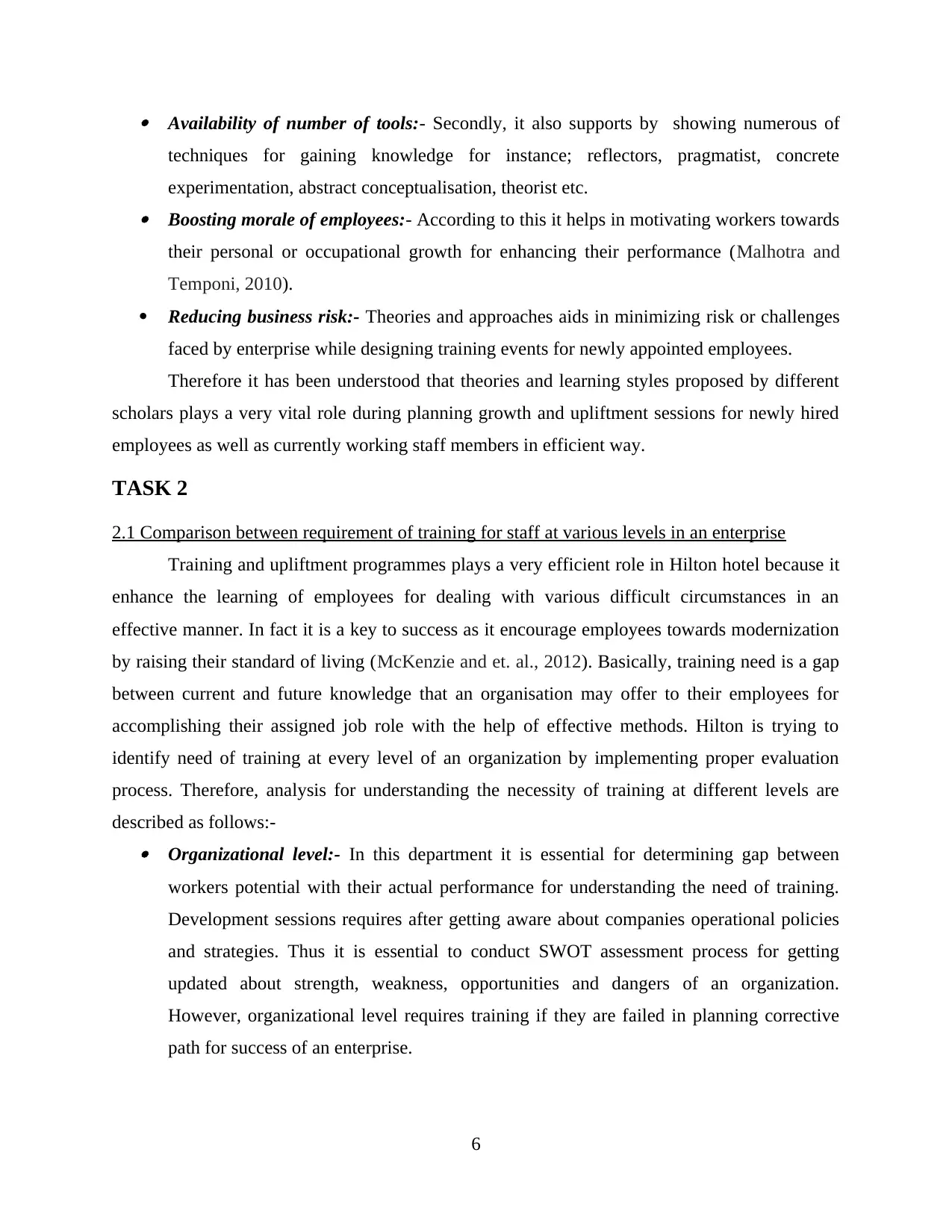
Availability of number of tools:- Secondly, it also supports by showing numerous of
techniques for gaining knowledge for instance; reflectors, pragmatist, concrete
experimentation, abstract conceptualisation, theorist etc. Boosting morale of employees:- According to this it helps in motivating workers towards
their personal or occupational growth for enhancing their performance (Malhotra and
Temponi, 2010).
Reducing business risk:- Theories and approaches aids in minimizing risk or challenges
faced by enterprise while designing training events for newly appointed employees.
Therefore it has been understood that theories and learning styles proposed by different
scholars plays a very vital role during planning growth and upliftment sessions for newly hired
employees as well as currently working staff members in efficient way.
TASK 2
2.1 Comparison between requirement of training for staff at various levels in an enterprise
Training and upliftment programmes plays a very efficient role in Hilton hotel because it
enhance the learning of employees for dealing with various difficult circumstances in an
effective manner. In fact it is a key to success as it encourage employees towards modernization
by raising their standard of living (McKenzie and et. al., 2012). Basically, training need is a gap
between current and future knowledge that an organisation may offer to their employees for
accomplishing their assigned job role with the help of effective methods. Hilton is trying to
identify need of training at every level of an organization by implementing proper evaluation
process. Therefore, analysis for understanding the necessity of training at different levels are
described as follows:- Organizational level:- In this department it is essential for determining gap between
workers potential with their actual performance for understanding the need of training.
Development sessions requires after getting aware about companies operational policies
and strategies. Thus it is essential to conduct SWOT assessment process for getting
updated about strength, weakness, opportunities and dangers of an organization.
However, organizational level requires training if they are failed in planning corrective
path for success of an enterprise.
6
techniques for gaining knowledge for instance; reflectors, pragmatist, concrete
experimentation, abstract conceptualisation, theorist etc. Boosting morale of employees:- According to this it helps in motivating workers towards
their personal or occupational growth for enhancing their performance (Malhotra and
Temponi, 2010).
Reducing business risk:- Theories and approaches aids in minimizing risk or challenges
faced by enterprise while designing training events for newly appointed employees.
Therefore it has been understood that theories and learning styles proposed by different
scholars plays a very vital role during planning growth and upliftment sessions for newly hired
employees as well as currently working staff members in efficient way.
TASK 2
2.1 Comparison between requirement of training for staff at various levels in an enterprise
Training and upliftment programmes plays a very efficient role in Hilton hotel because it
enhance the learning of employees for dealing with various difficult circumstances in an
effective manner. In fact it is a key to success as it encourage employees towards modernization
by raising their standard of living (McKenzie and et. al., 2012). Basically, training need is a gap
between current and future knowledge that an organisation may offer to their employees for
accomplishing their assigned job role with the help of effective methods. Hilton is trying to
identify need of training at every level of an organization by implementing proper evaluation
process. Therefore, analysis for understanding the necessity of training at different levels are
described as follows:- Organizational level:- In this department it is essential for determining gap between
workers potential with their actual performance for understanding the need of training.
Development sessions requires after getting aware about companies operational policies
and strategies. Thus it is essential to conduct SWOT assessment process for getting
updated about strength, weakness, opportunities and dangers of an organization.
However, organizational level requires training if they are failed in planning corrective
path for success of an enterprise.
6
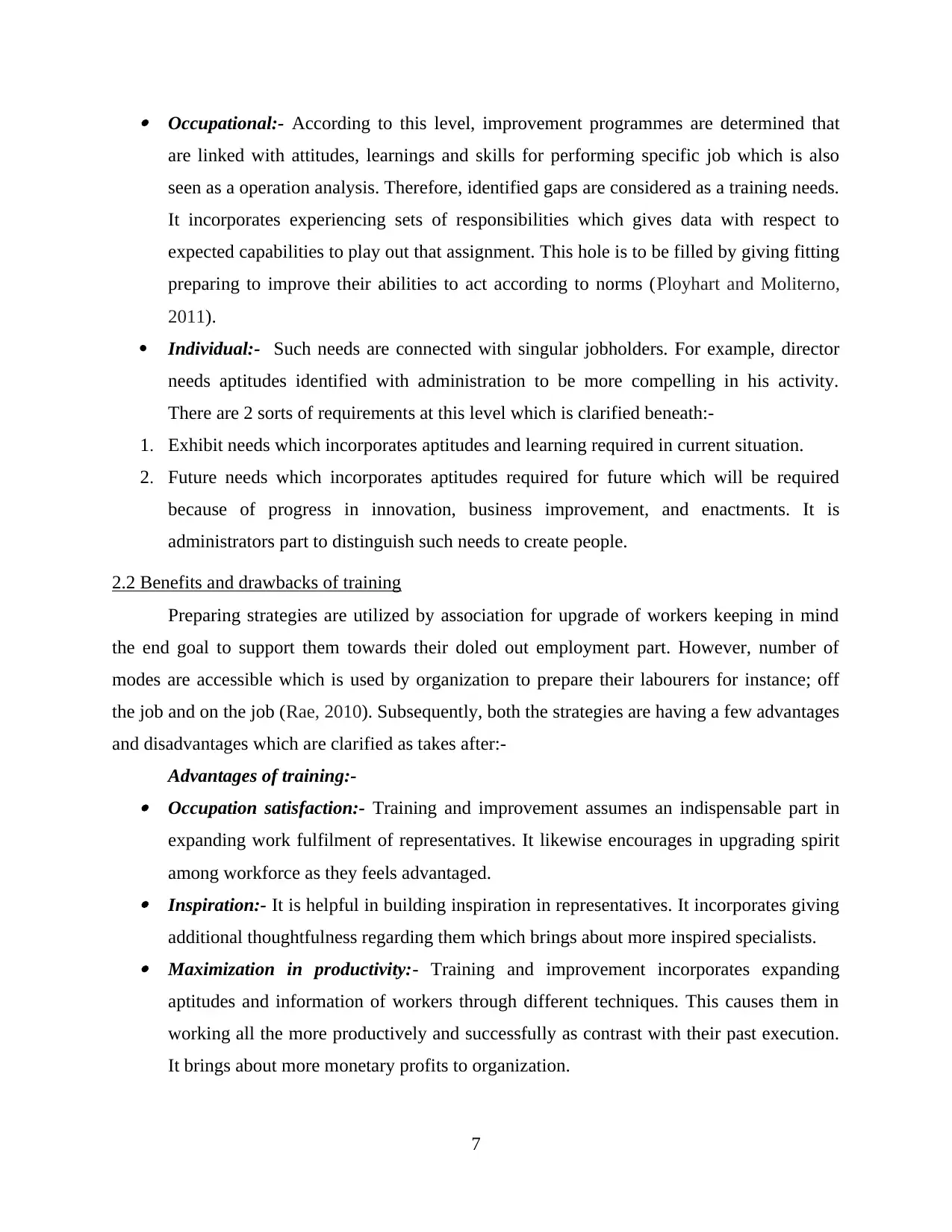
Occupational:- According to this level, improvement programmes are determined that
are linked with attitudes, learnings and skills for performing specific job which is also
seen as a operation analysis. Therefore, identified gaps are considered as a training needs.
It incorporates experiencing sets of responsibilities which gives data with respect to
expected capabilities to play out that assignment. This hole is to be filled by giving fitting
preparing to improve their abilities to act according to norms (Ployhart and Moliterno,
2011).
Individual:- Such needs are connected with singular jobholders. For example, director
needs aptitudes identified with administration to be more compelling in his activity.
There are 2 sorts of requirements at this level which is clarified beneath:-
1. Exhibit needs which incorporates aptitudes and learning required in current situation.
2. Future needs which incorporates aptitudes required for future which will be required
because of progress in innovation, business improvement, and enactments. It is
administrators part to distinguish such needs to create people.
2.2 Benefits and drawbacks of training
Preparing strategies are utilized by association for upgrade of workers keeping in mind
the end goal to support them towards their doled out employment part. However, number of
modes are accessible which is used by organization to prepare their labourers for instance; off
the job and on the job (Rae, 2010). Subsequently, both the strategies are having a few advantages
and disadvantages which are clarified as takes after:-
Advantages of training:- Occupation satisfaction:- Training and improvement assumes an indispensable part in
expanding work fulfilment of representatives. It likewise encourages in upgrading spirit
among workforce as they feels advantaged. Inspiration:- It is helpful in building inspiration in representatives. It incorporates giving
additional thoughtfulness regarding them which brings about more inspired specialists. Maximization in productivity:- Training and improvement incorporates expanding
aptitudes and information of workers through different techniques. This causes them in
working all the more productively and successfully as contrast with their past execution.
It brings about more monetary profits to organization.
7
are linked with attitudes, learnings and skills for performing specific job which is also
seen as a operation analysis. Therefore, identified gaps are considered as a training needs.
It incorporates experiencing sets of responsibilities which gives data with respect to
expected capabilities to play out that assignment. This hole is to be filled by giving fitting
preparing to improve their abilities to act according to norms (Ployhart and Moliterno,
2011).
Individual:- Such needs are connected with singular jobholders. For example, director
needs aptitudes identified with administration to be more compelling in his activity.
There are 2 sorts of requirements at this level which is clarified beneath:-
1. Exhibit needs which incorporates aptitudes and learning required in current situation.
2. Future needs which incorporates aptitudes required for future which will be required
because of progress in innovation, business improvement, and enactments. It is
administrators part to distinguish such needs to create people.
2.2 Benefits and drawbacks of training
Preparing strategies are utilized by association for upgrade of workers keeping in mind
the end goal to support them towards their doled out employment part. However, number of
modes are accessible which is used by organization to prepare their labourers for instance; off
the job and on the job (Rae, 2010). Subsequently, both the strategies are having a few advantages
and disadvantages which are clarified as takes after:-
Advantages of training:- Occupation satisfaction:- Training and improvement assumes an indispensable part in
expanding work fulfilment of representatives. It likewise encourages in upgrading spirit
among workforce as they feels advantaged. Inspiration:- It is helpful in building inspiration in representatives. It incorporates giving
additional thoughtfulness regarding them which brings about more inspired specialists. Maximization in productivity:- Training and improvement incorporates expanding
aptitudes and information of workers through different techniques. This causes them in
working all the more productively and successfully as contrast with their past execution.
It brings about more monetary profits to organization.
7
⊘ This is a preview!⊘
Do you want full access?
Subscribe today to unlock all pages.

Trusted by 1+ million students worldwide
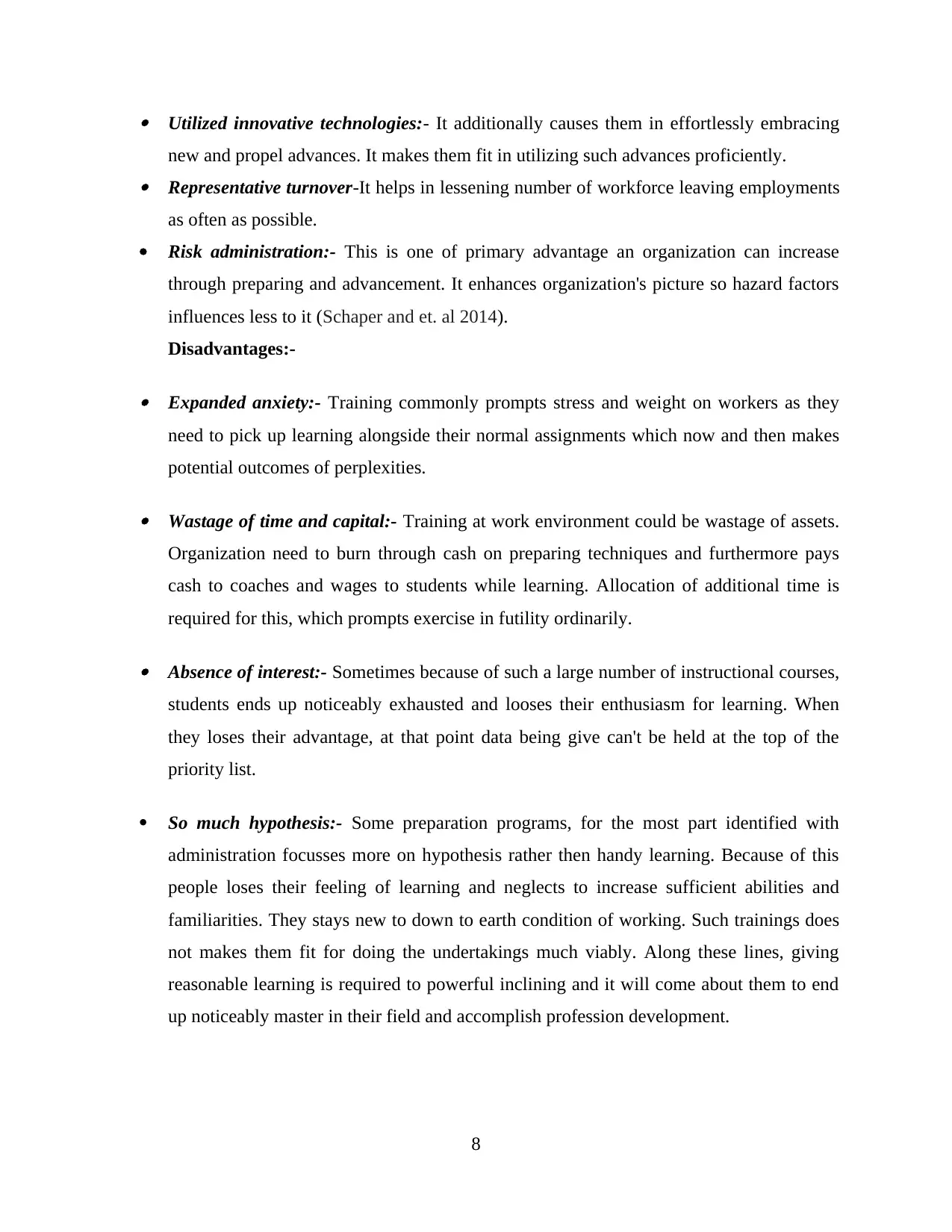
Utilized innovative technologies:- It additionally causes them in effortlessly embracing
new and propel advances. It makes them fit in utilizing such advances proficiently. Representative turnover-It helps in lessening number of workforce leaving employments
as often as possible.
Risk administration:- This is one of primary advantage an organization can increase
through preparing and advancement. It enhances organization's picture so hazard factors
influences less to it (Schaper and et. al 2014).
Disadvantages:-
Expanded anxiety:- Training commonly prompts stress and weight on workers as they
need to pick up learning alongside their normal assignments which now and then makes
potential outcomes of perplexities.
Wastage of time and capital:- Training at work environment could be wastage of assets.
Organization need to burn through cash on preparing techniques and furthermore pays
cash to coaches and wages to students while learning. Allocation of additional time is
required for this, which prompts exercise in futility ordinarily.
Absence of interest:- Sometimes because of such a large number of instructional courses,
students ends up noticeably exhausted and looses their enthusiasm for learning. When
they loses their advantage, at that point data being give can't be held at the top of the
priority list.
So much hypothesis:- Some preparation programs, for the most part identified with
administration focusses more on hypothesis rather then handy learning. Because of this
people loses their feeling of learning and neglects to increase sufficient abilities and
familiarities. They stays new to down to earth condition of working. Such trainings does
not makes them fit for doing the undertakings much viably. Along these lines, giving
reasonable learning is required to powerful inclining and it will come about them to end
up noticeably master in their field and accomplish profession development.
8
new and propel advances. It makes them fit in utilizing such advances proficiently. Representative turnover-It helps in lessening number of workforce leaving employments
as often as possible.
Risk administration:- This is one of primary advantage an organization can increase
through preparing and advancement. It enhances organization's picture so hazard factors
influences less to it (Schaper and et. al 2014).
Disadvantages:-
Expanded anxiety:- Training commonly prompts stress and weight on workers as they
need to pick up learning alongside their normal assignments which now and then makes
potential outcomes of perplexities.
Wastage of time and capital:- Training at work environment could be wastage of assets.
Organization need to burn through cash on preparing techniques and furthermore pays
cash to coaches and wages to students while learning. Allocation of additional time is
required for this, which prompts exercise in futility ordinarily.
Absence of interest:- Sometimes because of such a large number of instructional courses,
students ends up noticeably exhausted and looses their enthusiasm for learning. When
they loses their advantage, at that point data being give can't be held at the top of the
priority list.
So much hypothesis:- Some preparation programs, for the most part identified with
administration focusses more on hypothesis rather then handy learning. Because of this
people loses their feeling of learning and neglects to increase sufficient abilities and
familiarities. They stays new to down to earth condition of working. Such trainings does
not makes them fit for doing the undertakings much viably. Along these lines, giving
reasonable learning is required to powerful inclining and it will come about them to end
up noticeably master in their field and accomplish profession development.
8
Paraphrase This Document
Need a fresh take? Get an instant paraphrase of this document with our AI Paraphraser
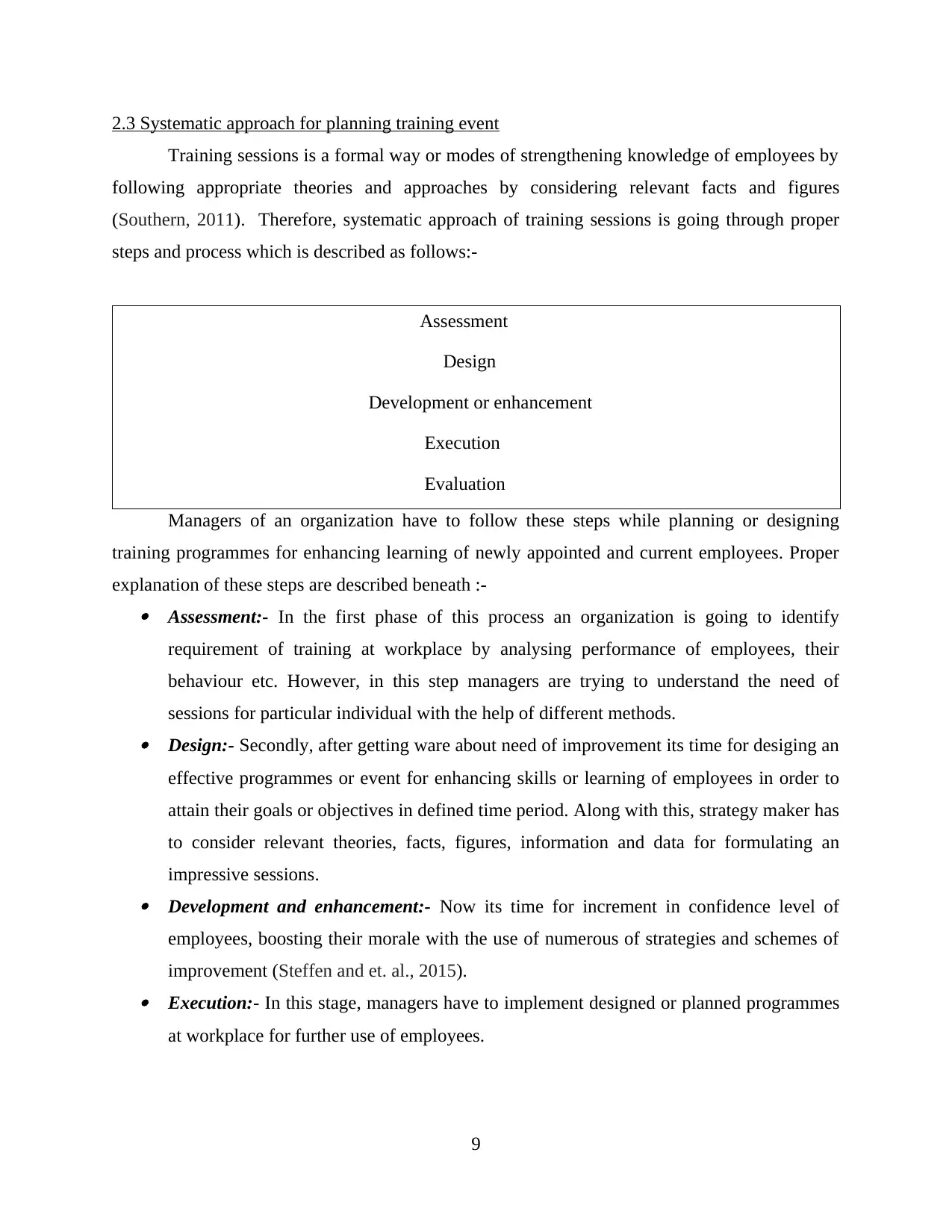
2.3 Systematic approach for planning training event
Training sessions is a formal way or modes of strengthening knowledge of employees by
following appropriate theories and approaches by considering relevant facts and figures
(Southern, 2011). Therefore, systematic approach of training sessions is going through proper
steps and process which is described as follows:-
Assessment
Design
Development or enhancement
Execution
Evaluation
Managers of an organization have to follow these steps while planning or designing
training programmes for enhancing learning of newly appointed and current employees. Proper
explanation of these steps are described beneath :- Assessment:- In the first phase of this process an organization is going to identify
requirement of training at workplace by analysing performance of employees, their
behaviour etc. However, in this step managers are trying to understand the need of
sessions for particular individual with the help of different methods. Design:- Secondly, after getting ware about need of improvement its time for desiging an
effective programmes or event for enhancing skills or learning of employees in order to
attain their goals or objectives in defined time period. Along with this, strategy maker has
to consider relevant theories, facts, figures, information and data for formulating an
impressive sessions. Development and enhancement:- Now its time for increment in confidence level of
employees, boosting their morale with the use of numerous of strategies and schemes of
improvement (Steffen and et. al., 2015). Execution:- In this stage, managers have to implement designed or planned programmes
at workplace for further use of employees.
9
Training sessions is a formal way or modes of strengthening knowledge of employees by
following appropriate theories and approaches by considering relevant facts and figures
(Southern, 2011). Therefore, systematic approach of training sessions is going through proper
steps and process which is described as follows:-
Assessment
Design
Development or enhancement
Execution
Evaluation
Managers of an organization have to follow these steps while planning or designing
training programmes for enhancing learning of newly appointed and current employees. Proper
explanation of these steps are described beneath :- Assessment:- In the first phase of this process an organization is going to identify
requirement of training at workplace by analysing performance of employees, their
behaviour etc. However, in this step managers are trying to understand the need of
sessions for particular individual with the help of different methods. Design:- Secondly, after getting ware about need of improvement its time for desiging an
effective programmes or event for enhancing skills or learning of employees in order to
attain their goals or objectives in defined time period. Along with this, strategy maker has
to consider relevant theories, facts, figures, information and data for formulating an
impressive sessions. Development and enhancement:- Now its time for increment in confidence level of
employees, boosting their morale with the use of numerous of strategies and schemes of
improvement (Steffen and et. al., 2015). Execution:- In this stage, managers have to implement designed or planned programmes
at workplace for further use of employees.
9
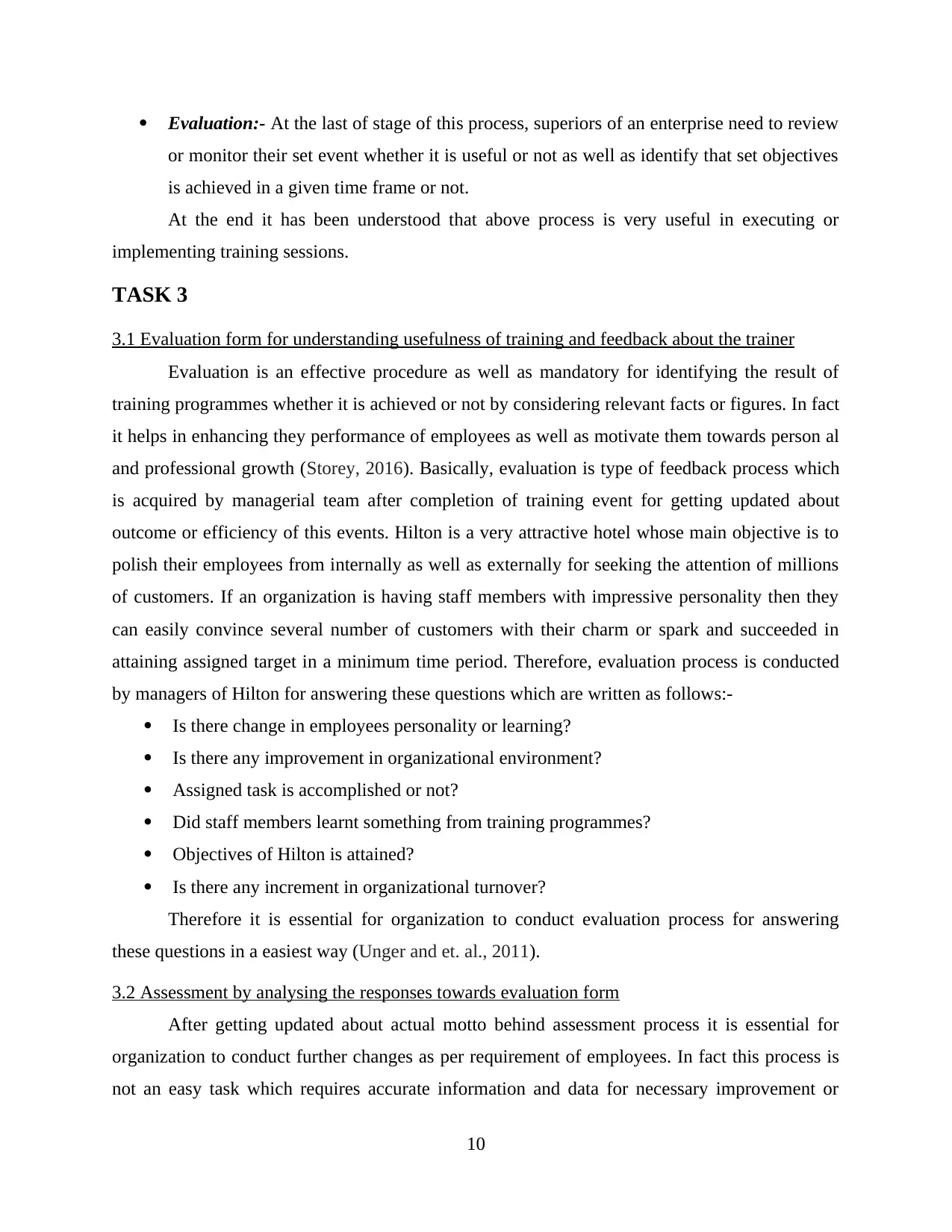
Evaluation:- At the last of stage of this process, superiors of an enterprise need to review
or monitor their set event whether it is useful or not as well as identify that set objectives
is achieved in a given time frame or not.
At the end it has been understood that above process is very useful in executing or
implementing training sessions.
TASK 3
3.1 Evaluation form for understanding usefulness of training and feedback about the trainer
Evaluation is an effective procedure as well as mandatory for identifying the result of
training programmes whether it is achieved or not by considering relevant facts or figures. In fact
it helps in enhancing they performance of employees as well as motivate them towards person al
and professional growth (Storey, 2016). Basically, evaluation is type of feedback process which
is acquired by managerial team after completion of training event for getting updated about
outcome or efficiency of this events. Hilton is a very attractive hotel whose main objective is to
polish their employees from internally as well as externally for seeking the attention of millions
of customers. If an organization is having staff members with impressive personality then they
can easily convince several number of customers with their charm or spark and succeeded in
attaining assigned target in a minimum time period. Therefore, evaluation process is conducted
by managers of Hilton for answering these questions which are written as follows:-
Is there change in employees personality or learning?
Is there any improvement in organizational environment?
Assigned task is accomplished or not?
Did staff members learnt something from training programmes?
Objectives of Hilton is attained?
Is there any increment in organizational turnover?
Therefore it is essential for organization to conduct evaluation process for answering
these questions in a easiest way (Unger and et. al., 2011).
3.2 Assessment by analysing the responses towards evaluation form
After getting updated about actual motto behind assessment process it is essential for
organization to conduct further changes as per requirement of employees. In fact this process is
not an easy task which requires accurate information and data for necessary improvement or
10
or monitor their set event whether it is useful or not as well as identify that set objectives
is achieved in a given time frame or not.
At the end it has been understood that above process is very useful in executing or
implementing training sessions.
TASK 3
3.1 Evaluation form for understanding usefulness of training and feedback about the trainer
Evaluation is an effective procedure as well as mandatory for identifying the result of
training programmes whether it is achieved or not by considering relevant facts or figures. In fact
it helps in enhancing they performance of employees as well as motivate them towards person al
and professional growth (Storey, 2016). Basically, evaluation is type of feedback process which
is acquired by managerial team after completion of training event for getting updated about
outcome or efficiency of this events. Hilton is a very attractive hotel whose main objective is to
polish their employees from internally as well as externally for seeking the attention of millions
of customers. If an organization is having staff members with impressive personality then they
can easily convince several number of customers with their charm or spark and succeeded in
attaining assigned target in a minimum time period. Therefore, evaluation process is conducted
by managers of Hilton for answering these questions which are written as follows:-
Is there change in employees personality or learning?
Is there any improvement in organizational environment?
Assigned task is accomplished or not?
Did staff members learnt something from training programmes?
Objectives of Hilton is attained?
Is there any increment in organizational turnover?
Therefore it is essential for organization to conduct evaluation process for answering
these questions in a easiest way (Unger and et. al., 2011).
3.2 Assessment by analysing the responses towards evaluation form
After getting updated about actual motto behind assessment process it is essential for
organization to conduct further changes as per requirement of employees. In fact this process is
not an easy task which requires accurate information and data for necessary improvement or
10
⊘ This is a preview!⊘
Do you want full access?
Subscribe today to unlock all pages.

Trusted by 1+ million students worldwide
1 out of 21
Related Documents
Your All-in-One AI-Powered Toolkit for Academic Success.
+13062052269
info@desklib.com
Available 24*7 on WhatsApp / Email
![[object Object]](/_next/static/media/star-bottom.7253800d.svg)
Unlock your academic potential
Copyright © 2020–2025 A2Z Services. All Rights Reserved. Developed and managed by ZUCOL.




